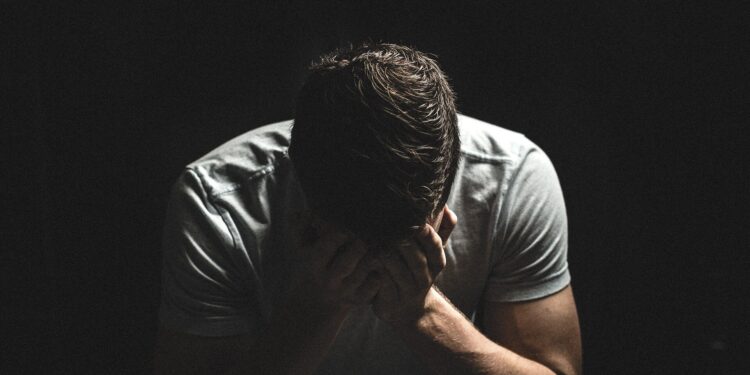Credit: Pixabay/CC0 Public domain
White Americans in the United States are more likely than blacks and Hispanics to experience “deaths of despair,” even though they are less likely to suffer serious psychological distress, a new study finds.
The findings suggest that, for whatever reason, white people are more vulnerable to the harmful effects of psychological distress than blacks or Hispanics, said Hui Zheng, lead author of the study and professor of sociology at Ohio State University. . Zheng is currently on leave at the University of Hong Kong.
“The white population is experiencing an increasing trend of despair-related mortality after 2000,” Zheng said. “They are more likely to die of despair than blacks and Hispanics, even though they have lower levels of despair overall.”
Another key finding is that, for white and black Americans, deaths from despair go beyond deaths related to drugs, alcohol and suicide.
“The influence of hopelessness appears to extend to a broader range of causes of death, such as obesity, cardiovascular disease, cancer and Alzheimer’s disease,” Zheng said.
The study, co-authored by Yoonyoung Choi, a doctoral student in sociology at Ohio State, was published in Proceedings of the National Academy of Sciences.
Zheng said the study provides a direct test of hopelessness as a determinant of death and assesses how it may vary over time and across race and ethnicity.
Anne Case and Angus Deaton, economists at Princeton University, first wrote about the “deaths of despair” in a 2015 paper. PNAS paper. They argued that despair had led to increases in drug-, alcohol- and suicide-related deaths, particularly among less-educated white Americans.
In this new study, Zheng and Choi reassessed this narrative of deaths of despair, using data from a variety of sources, including the U.S. National Health Survey Mortality File, the National Health Survey Database Centers for Disease Control and Prevention with Multiple Causes of Death, the CDC Bridged Breed Database. population files, Current Population Survey and American Community Survey.
Their final sample included 409,095 people. Researchers used “psychological distress” to measure hopelessness. In one of the data sets, respondents reported how often in the previous 30 days they felt sad, nervous, agitated, hopeless, or that everything was an effort. Based on their responses, participants were categorized into three groups, with the highest being severe distress.
Researchers looked at deaths between 1997 and 2014.
The results showed that the percentage of white Americans experiencing moderate or severe psychological distress increased steadily over the period studied. The increase was largest among whites without a college degree, who rose from 12.5% to 14.9%.
Trends in levels of psychological distress among blacks and Hispanics varied over the period, but Zheng noted that whites had a lower prevalence than other groups throughout the period studied.
This study cannot explain why levels of hopelessness increased among whites, but others have pointed to the loss of well-paying blue-collar jobs, a perceived relative loss of status, less religious participation, and a decline in marriage, a Zheng said.
What is clear from this study is that the impact of psychological distress is more severe on white Americans.
For example, between 1997 and 2002, one model showed that severe distress was associated with an increase in mortality of 114% among whites, but only 44% and 51% among blacks and Hispanics, respectively.
“The problem is that white Americans seem more vulnerable to despair: They are more likely to die from it,” Zheng said.
Other researchers have hypothesized that black and Hispanic Americans might be protected from the worst effects of psychological distress by higher levels of religiosity and stronger social support.
“These protective factors could mitigate the impact of hopelessness on blacks and Hispanics,” he said.
This study resulted in another major discovery that could revise Case and Deaton’s original conclusions. The Deaths of Despair narrative generally assumes that despair primarily leads to deaths related to drugs, alcohol, and suicide.
But Zheng and Choi found that in 1997, deaths from alcohol, drugs and suicide accounted for only about half of the total deaths of black and white Americans that could be linked to psychological distress.
“Just looking at deaths from drugs, alcohol and suicide underestimates the toll that despair takes on blacks and whites in the United States,” Zheng said.
“Psychological distress can lead to other health problems linked to mortality. It leads to stress, obesity, poor sleep, poor eating habits and other habits that contribute to cardiovascular disease, diabetes and cancer.”
On the other hand, focusing on drug, alcohol and suicide-related mortality overestimates the impact of hopelessness on mortality among Hispanics, the study found.
This suggests that hopelessness may not be the only cause of deaths from drugs, alcohol and suicide, he said.
Overall, the findings suggest that hopelessness may be one of the driving factors behind the trend in alcohol-, drug- and suicide-related deaths among whites, but not among blacks and Hispanics.
“We need more research to identify the underlying factors that create these different trends in susceptibility to hopelessness among different racial and ethnic groups,” Zheng said.
More information:
Zheng, Hui et al, Reassessing the “Deaths of Despair” Narrative: Racial/Ethnic Heterogeneity in the Trend of Psychological Distress-Related Deaths, Proceedings of the National Academy of Sciences (2024). DOI: 10.1073/pnas.2307656121. doi.org/10.1073/pnas.2307656121
Provided by Ohio State University
Quote: Study finds white Americans most susceptible to psychological distress (February 5, 2024) retrieved February 5, 2024 from
This document is subject to copyright. Except for fair use for private study or research purposes, no part may be reproduced without written permission. The content is provided for information only.



